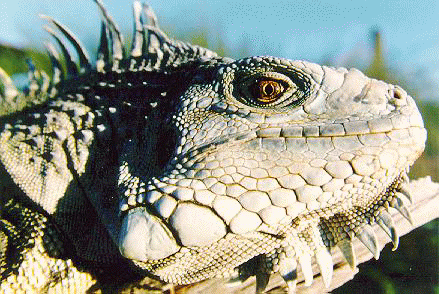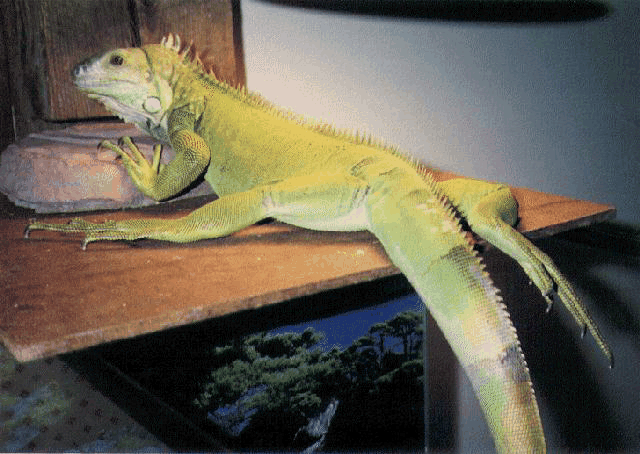
This is a green iguana, also known as a common iguana. At the pets stores this is the main type of iquana for sell.
Have you ever seen one this close up?? I think that they are beautiful and have had several myself as pets. But if you think that he isn't pretty that is the way you feel. Many people feel strongly one way or the other,I myself have at times just thought of them as funny looking..or that they look to much like a snake( I have a fear of snakes -and to help get over this-I now have snakes as pets).
Have you ever watched an old dinosaur movie and seen that
it was just a lizard put in a tiny town. Most of them have been iguanas
because of the dorsal fins (I think)..
here is a
picture of one being done that way..looks big don't he?
Actually
green iguanas can grow to be over 6 feet long. Most of that is there tail which
when they are in danger they will release it so that they can escape or if not
to frighten they will pop you with it like a whip (which does hurt )!
They usually do this while they are juveniles, and less often when adult
(less preditors feed on them once they are grown).
They are also vegetarians so if you have one feed it plenty of different fruits and
vegetables and also buy reptile vitamins and calcium. Many reptiles that are
pets don't get the proper diet that they would get in the wild so we have
to give them vitamins to make up for it. Many pet iguanas have died from
metabolic bone disease,this is caused from a lack of vitamin D. Always buy
a book about something before you buy it. And even thought someone at the pet
shop might say they know everything, sometimes they are misinformed so its best
to just go ahead and read up on it first, you might also realize this way that
this isn't the pet for you and pick a different type of lizard.
Iguanas
also need lots of real sunlight and plenty of growing room, because of this
some people let there iguanas rome the house once they are big enought not to get out
by finding cracks or air vents.But if you do this make sure your home is extra warm
and plenty of sunlight.

But you will still need to take your pet outside for sunlight
it coming throught the window is not the full spectrum. They have special bulbs you can buy for
this but I perfer to buy a leash and teach them to behave on it. Yes I have been outside
walking an iguana.hahaha.
This is a marine iquana and they spend plenty of time laying
on the beach and the rocks at the beach. They jump off the cliffs and dive into the ocean
so that they can get to the plant life at the bottom for food. They are also vegetarians
and there diet is dirived from plant live in the ocean.
The Marine Iguana is an endangered species and are not being properly protected. They come from small southern islands out of U.S. jurisdiction(not that that would really help) and the islands they are on are more interested in making hotels and getting into the torist business, special groups are working and tring to save some of the beach for the Marine Iguana but the problem is far from solved.
Another type of Iguana is the Cyclura species most familiar to hobbyist is the rhinoceros iguana but also in this family is the rock iguana, and the cuban iguana.
Many iguanas of the genus Cyclura are in danger of extinction if they do not receive adequate protection. Only the Cuban iguanas from the island population off Puerto Rico are exempt from threatened status and can be shipped interstate without permits.
But the Navassa Island rhinoceros iguana is believed to be extinct. Two others the Jamaican rock iguana, and the Grand Cayman blue rock iguana, are barely hanging on with possibly less than 100 individuals of each remaining in the wild of their respective islands.
Fortunately, captive-breeding programs have begun recently in both Jamaica and on Grand Cayman Island with the goal of raising hatchling rock iguanas up to 2 or 3 years of age when they attain a size at which they are no longer vulnerable to predators. They hope to give them a "head start" in protected areas that are able to support there population.

Also in the Rock Iguana family and on the endangered list is the Turks and Caicos Island Rock Iguanas.
They are located at the end of the chain of the Bahamas.
Although not commonly known and very rarely heard of, there have been some kept in captivity, but never for very long,
it has always ended in them dieing, even with zoos tring to take care
of them there has been no success ,if it had been successful then they would of then tried to breed them.
The last time the United States tried to do this was in 1977
at the Knoxville Zoological Gardens in Knoxbille, Tennessee.
At the moment only leaving them alone and not messing with there habitat seems to be the only thing to do for them.
This page hosted by